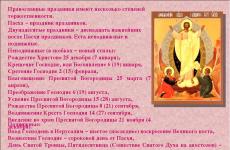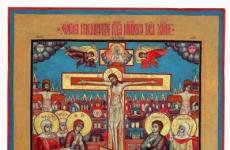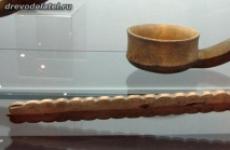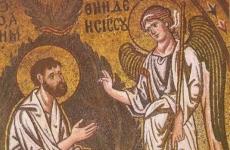Print fairy tales for reading by syllables. We read stories and fairy tales for children in syllables. How to prepare texts for reading by syllables
Learning to read in syllables - this stage in teaching children to read is one of the most important and difficult. Often parents simply do not know how to teach a child to pronounce two letters together and get stuck on it for a long time. Tired of the endless repetition of "ME and A will be MA", the child quickly loses interest, and learning to read turns into torment for the whole family. As a result, children who already know letters from the age of two or three cannot even read simple words by the age of five, not to mention reading sentences and books.
What to do next when the child has memorized the letters? Let's make a reservation right away that teaching a preschooler to read syllables can be started even BEFORE he has mastered the entire alphabet (moreover, some teachers insist that you need to move on to syllables as quickly as possible, without waiting for all the letters to be studied). But those letters that we will combine into syllables, the child must name without hesitation.
In order to start learning to read by syllables, it is enough for a child to know 3-4 vowels and a few consonants. First of all, take those consonants that can be pulled (S, Z, L, M, N, V, F), this will help teach the child the continuous pronunciation of the syllable. And this is a fundamentally important point.
So, let's consider a few, in our opinion, the most effective methods that modern teachers offer for teaching a child to fold letters into syllables.
1. We play "Engines"
(a game from the manual by E. Baranova, O. Razumovskaya "How to teach your child to read").
Instead of boring cramming, invite your child to "ride the train." All consonants are written on the rails along which our trailers will go, and vowels are written on the trailers themselves. We place the trailer on the rails so that a consonant appears in the window, and we name which station we got (for example, BA). Next, we move the trailer down the rails - to the next consonant and read the syllable that appears.
There is a similar guide in cards "Game" Steam locomotive. We read syllables. from E. Sataeva
This game is good because the child does not need to be specially explained how to add syllables. It is enough to say: “Now we will ride the letter A, she will be our passenger, name all the stations at which we will make a stop.” To begin with, “ride” yourself - let the child move the trailer along the rails, and you loudly and clearly call the “stations”: BA, VA, GA, YES, ZHA, ZA, etc. Then invite your child to take turns doing this with you. During the game, listening to you, children easily grasp how to pronounce two sounds together. For the third time, the child will “ride” himself without much difficulty.
If the child does not know all the letters, stop only at those “stations” that are familiar to him. Next, we change the wagon. Now we roll the letters O, U, S. If the child can easily cope with the task, we complicate the task. For example, we ride at speed - timing which of the wagons will reach the end of the path first. Or another option: stopping at the station, the child must name not only the syllable, but also the words starting with this syllable (BO - barrel, side, Borya; VO - wolf, air, eight; GO - city, golfs, guests; DO - rain, daughter, boards, etc.).
Please note that with this game you can practice reading not only open syllables (with a vowel at the end), but also closed ones (with a consonant at the end).
To do this, we take trailers where the vowels are written in front of the window, and act in the same way. Now we have a letter on the trailer not a passenger, but a driver, she is the main one, she is in front. First read the resulting “stations” with closed syllables yourself: AB, AB, AG, AD, AZH, AZ, etc., then offer the child a “ride”.
Remember that in this and other exercises, we first practice adding syllables with first-row vowels (A, O, E, Y, Y), and then we introduce second-row vowels (I, E, E, Yu, I) - the so-called "iotized" vowels, which make the sound that precedes them soft.
When the child is good at reading separate tracks with syllables, alternate wagons with passengers and drivers, without prompting which wagon we will roll. This will help the child learn to clearly see exactly where the vowel is in the syllable (the syllable begins with it or ends with it). At first, learning to read by syllables in a child may have difficulties with this.
2. "Run" from one letter to another
(from "ABC for kids" by O. Zhukova)This is a visual exercise that will help the child learn to pronounce two letters together.

Before us is a path from one letter to another. To overcome it, you need to pull the first letter until the finger that we are leading along the path reaches the second letter. The main thing we are working on in this exercise is that there is no pause between the first and second sound. In order to make it more interesting to study, replace your finger with a figure of any animal / little man - let him run along the path and connect two letters.
("ABC book for kids" by E. Bakhtina, "Russian alphabet" by O. Zhukova and others).
 Many authors of primers and alphabets use animated images of letters that need to be folded into a syllable - they are friends, walk together in pairs, pull each other through obstacles. The main thing in such tasks, as in the previous exercise, is to name two letters together so that the two girlfriend letters stay together.
Many authors of primers and alphabets use animated images of letters that need to be folded into a syllable - they are friends, walk together in pairs, pull each other through obstacles. The main thing in such tasks, as in the previous exercise, is to name two letters together so that the two girlfriend letters stay together.

To use this technique, you do not even need special manuals or primers. Print out several figures of boys and girls (animals, fairy-tale or fictional characters), write a letter on each of them. Let consonants be written on the figures of boys, and vowels on the figures of girls. Make friends with the kids. Check with your child that boys and girls or two girls can be friends, but it is not possible to make friends with two boys (pronounce two consonants together). Change pairs, put girls first in them, and then boys.

Read the syllables first in one order, then in reverse.
These few tricks are quite enough to teach a child to put two letters into a syllable. And learning in the form of a game will allow you to avoid cramming and boring repetition of the same thing.
4. Games to consolidate the skill of adding letters
- Syllabic Lotto
It is very easy to make them yourself, for this you need to pick up a few pictures - 6 for each card and print the corresponding syllables.

- Help will help you “Syllables. Choose a picture according to the first syllable BA-, VA-, MA-, SA-, TA-. Educational lotto games. GEF DO "E. V. Vasilyeva- there are a few more tutorials in this series “Letters, syllables and words. Lotto with verification” by A. Anikushena
- Similar exercises are in the book. "Syllabic tables. GEF "N. Neshchaeva
- Shop game
Lay out toy goods or pictures with their images on the counter (for example, FISH-ba, DY-nya, PI-horns, BU-lka, YaB-loki, MYA-so). Prepare "money" - pieces of paper with the name of the first syllables of these words. A child can buy goods only for those “bills” on which the correct syllable is written.
Make an album with your child with your own hands, in which a syllable will be written on one page of the spread, and on the other - objects whose name begins with this syllable. Periodically review and supplement these albums. For more effective learning to read, close one or the other half of the turn (so that the child does not have extra clues when naming a syllable or choosing words for a particular syllable).

This will help you "Cards for sound and syllabic analysis of words."
- Game in the airfield (garages)
We write syllables large on sheets of paper, lay them out around the room. These will be different airfields (garages) in our game. The child takes a toy plane (car), and the adult commands - on which airfield (in which garage) you need to land the plane (park the car).
For this exercise, Zaitsev cubes or any cards with syllables are suitable (you can make them in the form of traces). We build a long path from them - from one end of the room to the other. Choose two figurines / toys. You play one, the child plays the other. Roll the dice - take turns with your figures on the cards for as many moves as fell on the dice. Stepping on each card, name the syllable written on it.
For this game, you can also use various "walkers" by writing syllables in circles on the playing field.

5. Reading simple words by syllables
Simultaneously with the development of syllables, we begin to read simple words (of three or four letters). For clarity, so that the child understands what parts the word consists of, which letters should be read together and which separately, we recommend that the first words be composed of cards with syllables / individual letters or graphically divide the word into parts.

Words of two syllables can be written on pictures consisting of two parts. Pictures are easier to understand (the child is more willing to read the words written on them than just columns of words), plus it is clearly visible into which parts a word can be broken down when reading it syllable by syllable.

Increase the difficulty gradually: start with words consisting of one syllable (UM, OH, EM, UZH, Hedgehog) or two identical syllables: MOM, UNCLE, DAD, NANNYA. Then proceed to reading the words of three letters (closed syllable + consonant): BAL, SON, LAK, BOK, HOUSE.
You need to understand that even if a child pronounces all the syllables in a word correctly, this does not mean that he will immediately be able to meaningfully put them into a word. Be patient. If a child has difficulty reading words of 3-4 letters, do not proceed to reading longer words and especially sentences.
Be prepared for the fact that the child will freely begin to read words only after he has automated the skill of adding letters into syllables. Until this happens, periodically return to working out syllables.
And, most importantly, remember that any learning should be a joy - for both parents and children!
Philologist, teacher of Russian language and literature, teacher of preschool education
Svetlana Zyryanova
FRIENDS
Ni-ki-ta and Le-sha are friends. Together they go to kindergarten. Lesha has a sa-mo-kat. And Ni-ki-you has a ru-zhe. Not really standing, but playing. These boys are good fellows. Oh-no always de-la-tsya games-rush-ka-mi. And they never quarrel. Together we play and laugh. Ho-ro-sho friend!
ZO-LO-TOE EGG-KO
Live se-be grandfather and ba-ba and they would have ku-roch-ka rya-ba. He took down a ku-roch-ka egg-ko: the egg is not simple - it's golden.
Grandfather beat - beat - not beaten.
Ba-ba bi-la, bi-la - more than once-bi-la.
The mouse be-zha-la, the tail-tee-com mah-nu-la, the egg fell-lo and broke-elk.
Grandfather and ba-ba cry, ku-roch-ka ku-dah-chet:
“Don't cry, grandfather, don't cry, ba-ba!
I'll take you an egg to another,
Not golden - simple!
MU-RA-WEI AND GO-LUB-KA
Mu-ra-vei went down to the stream: for-ho-tel for a drink. Wave-on for-whip-well-la e-th and almost in a pi-la. Go-lub-ka carried a vet-ku; o-na u-vi-de-la - mu-ra-vei then-no, and bro-si-la e-mu vet-ku in the ru-chey. Mu-ra-wei sat on a branch and escaped.
That's why o-hot-nick spread the network on go-lub-ku and wanted to clap. Mu-ra-vei crawled to o-hot-no-ku and u-ku-strength of e-go by the leg; oh-hot-nick oh-zero and u-ro-nil network. Go-lub-ka fluttered-well-la and u-le-te-la.

Pet-ti and Mi-shi had a horse. They began to argue: whose horse. Did they tear each other's cats.
Give it to me, this is my horse.
No, you give me, the horse is not yours, but mine.
Mother came, took a horse, and nobody's horse became.
L. Tolstoy
Three Bears.
One day, Ma-sha went into the forest and got lost. Began to search to-ro-gu to my yes came to the forest from the bush. In the house of e-thom lived seven-I honey-ve-dey: the father was called Mi-hi-lo Po-ta-pych, the mother - Nas-tas-ya Pet-rov-na , and their little laziness-ko-sy-nish-ku - honey-ve-jo-nok Mi-joking-ka. The house was empty - honey-ve-di ush-whether walking through the forest.
Ma-sha entered the house and w-wee-de-la had three bowls of porridge. Pain-sha-I would-la Mi-hi-lo Po-ta-py-cha, middle-ny-ya Us-tas-and Pet-rov-ny, and sa-ma-I laziness-ka-ya - M-jokes. In-pro-bo-va-la Ma-sha ka-shu from a large bowl, then from a middle one, and from a small one, Mi-joking-ki-noy, the whole shu ate.
For-ho-te-la Ma-sha pri-net and sees three chairs at the hundred-la. Climbed o-na onto a big chair and u-pa-la; sat on the middle chair - it was not-at-ad-but; sat down on a small stool and laughed. Became-la Ma-sha ka-chat-sya on the Mi-joking-ki-ne chair-chi-ke, ka-cha-las - ka-cha-las, why didn’t he slo-ma-la!
Send la Ma-sha to another mountain-ni-tsu. There are a hundred-I-whether three kro-va-ti. Lay down o-na in pain-shu-yu - it would be too spacious; lay down in the middle-nu-th - it would be too you-so-ko; and ma-laziness-ka-I came to her just right. Lay down Ma-sha and sleep-la.
Come back to my honey-ve-di from the forest, se-o-be-give. Mi-hi-lo Po-ta-pych looked into his bowl and growled: “Who ate from my bowl?” Us-tas-ya Pet-rov-na looked-re-la at the table and for-re-ve-la: “Who ate from my bowl?” And Mi-jokingly squeaked: “Who ate my porridge and broke my chair?”
Send honey-ve-di to another-gu-yu mountain-no-tsu. “Who lo-lived on my bed?” - roared Mi-hi-lo Po-ta-pych. “Who lay down on my bed and crushed it?” - for-re-ve-la Nas-tas-ya Pet-rov-on. And Mi-joking-ka u-vi-del in his cro-vat-ke de-voch-ku and squeaked: “Here oh! Hold her!
U-vi-dev honey-ve-day, Ma-sha o-chen is-pu-ga-las. O-on you-jump-well-la in the open-then-e-ok-but and be-m-la-to-my. And honey-ve-di didn’t dog-on-whether.
Children's texts for reading by syllables. Read on your own. When a child learns to read, some children need to read syllable by syllable, and some are more comfortable reading in full words without dashes. The page provides simple texts in both versions. We read in syllables.
There would be thunder. It was pouring heavy rain. Gre-chalk thunder. Stre-ko-za-bra-la-s under the mushroom. Mi-mo on do-ro-ge half-evil u-lit-ka. Stre-ko-for go-vo-rit:
- Wu-lit-ka, w-lit-ka! Come to me. Here soo-ho, like under. roofs.
- I don't need a roof! My house is with me.
Thunderstorm
There was a thunderstorm. It was pouring heavy rain. Thunder rumbled. The dragonfly climbed under the mushroom. A snail was crawling along the road. Dragonfly says:
- Snail, snail! Come to me. It's dry as hell in here. roof.
I don't need a roof! My house is with me.
It's not just a ve-dot
Mi-sha slo-small ma-le-n-cue du-bok.
- Why did you do this? - oh-gor-chi-la-s Ma-sha.
- Yes, it's just a hundred ve-dot-ka!
“No, you po-gu-beat pain-sho-e, mo-gu-che-de-re-vo,” said Ma-sha.
It's not just a branch
Misha broke a small oak tree.
– Why did you do it? Masha was upset.
- Yes, it's just a twig!
“No, you destroyed a big, mighty tree,” said Masha.
Ze-blah-no-ka
Re-bya-ta gu-la-li in the forest. Went-la Na-dya on-la-well. Looks: oh-ko-lo no-e red-we-e I-go-dy. I-a year would-lo not-much. Na-dya collected them in la-dosh-ku, but didn’t eat.
-Peter! Vasya! Come to me! Earth-la-no-ka! Per-va-I earth-la-no-ka!
When-be-zha-whether be-bya-ta. And everyone is two years old
- Oh, how taste-but!
Soon the earth-la-no-ki will be a lot. But the first I-go-dy-sa-we-e sun-nye.
strawberries
The children were walking in the forest. Nadia stepped out into the clearing. Looks: there are red berries near her. There were few berries. Nadia gathered them in her palm, but did not eat.
-Peter! Vasya! Come to me! Strawberries! First strawberry!
The guys came running. And everyone has two berries.
-Oh, how delicious!
There will be plenty of strawberries soon. But the first berries are the most delicious.
Morning
The boy and de-vo-chka go to school.
And Le-na drinks tea.
- Daughter, it's already seven o'clock! - go-vo-rit ma-ma
Le-na looks at the watch.
-Our watch is too-three, ma-moch-ka!
- No, Le-noch-ka. Hours are right. And you de-la-eat everything honey-le-no.
Morning
Boy and girl go to school.
And Lena drinks tea.
- Daughter, it's already eight o'clock! - Mom says
Lena looks at her watch.
-Our clock is going too fast, mommy!
- No, Lenochka. The clock is running right. And you do everything slowly.
In kindergarten, too, the beginning of the school year. Children gradually come from holidays. Many have learned letters over the summer and begin to read a little by syllables.
Where do texts for reading by syllables come from? Of course, from the primer. Old primers are interesting, according to which grandmothers studied. The second source is the Internet. We also prepare texts for our pupils of 5-6 years old, depending on the available skills, starting with simple and short texts. It is better to read little by little, but more often.
In the first syllable-reading texts, each sentence begins on a new line. This makes it easier for children to read the text. The first texts to read by syllables should be printed large.
It is useful to accompany them with coloring pages - a work familiar to preschoolers. Tasks are like this.
- First you need to read to your mother, grandmother or someone else.
- Colorize.
- Label the items in the picture.
Why write words? When a child reads, hearing and vision interact. When writing, - auditory (I pronounce), visual (I fix the image of the word) and motor analyzers.
In addition to narrative texts, it is useful to use short simple verses for reading by syllables.
How to prepare texts for reading by syllables?
Parents teaching their child to read can prepare the material themselves. You need to know the following. Texts for reading by syllables may look different. It all depends on how we divide the word into syllables.
1. We divide the words into syllables as in the primer with hyphens (short horizontal lines). Below, several texts are divided into syllables in this way.
2. Words are divided into syllables by vertical lines.
 3. Syllables are distinguished from below by arcs.
3. Syllables are distinguished from below by arcs.
 More or less like this. It is better to start with the first option with hyphens. The first texts should be very simple in content, as below, gradually getting more complicated.. First, you give a picture for coloring. And then the kid draws himself according to the meaning of the text. Reading texts can also be downloaded from our website. Just prepare them in one of the ways suggested above.
More or less like this. It is better to start with the first option with hyphens. The first texts should be very simple in content, as below, gradually getting more complicated.. First, you give a picture for coloring. And then the kid draws himself according to the meaning of the text. Reading texts can also be downloaded from our website. Just prepare them in one of the ways suggested above.
Texts to read by syllables
This is a cat Ku-zya.
At night, Ku-zya lo-vil mice.
That's why the cat slept on di-va-ne.
And we are si-de-li in a hole.
- Name of the cat?
- What are his actions?
- Why did mice sit in a mink?
Fishing.
Sa-ni had-la u-daughter.
Sa-nya on-ko-fell worms.
He went to the river.
There are fish in the river.
Sa-nya lo-vil fish-boo.
- Boy's name?
- What was he doing?
- How many fish did you catch?

Wood.
This is a tree.
De-re-va has a trunk.
Have de-re-va leaf.
At de-re-va vet-ki.
Question. Na-zo-vi de-re-vo.

Cow.
Ko-ro-va eats se-no.
Ko-ro-wa yes mo-lo-ko.
Ma-sha love-bit mo-lo-ko.
Ma-sha loves ka-shu.
Ma-sha has ru-me-we-cheeks.
Question. Why does Masha have rosy cheeks? (For some reason, all mothers thought about diathesis)
 In the woods.
In the woods.
De-ti went to the forest.
They are co-bi-ra-li ma-li-nu.
Next to the house for-tre-shcha-whether bushes.
De-ti is-pu-ha-lis.
And from the bushes you-be-zha-la so-ba-ka Zhuch-ka.
Everyone became ve-se-lo.
- Where did the children go?
- What were they doing in the forest?
- Who scared the kids?
Summer
Let something red-but-e.
Why o-but red-no-e?
Red-no-e, it means beauty-si-in-e.
Ze-le-ny-e le-sa.
Blue sky.
Bright flowers.
The beauty.
Na-ri-sui le something.
- Why is summer red?
- What forests?
- What a sky
- Which flowers?
- Why do you like summer?
Ko-lo-kol-chi-ki
Ko-lo-kol-chi-ki in-le-you-e-flowers.
Why o-no-le-you-e?
In a way, that the races are here in the field and in the meadow.
Ko-lo-kol-chi-ki si-ni-e
Li-za gu-la-et in the meadow.
Li-za co-bi-ra-et ko-lo-kol-chi-ki.
Li-za has a do-ma va-za.
There ko-lo-kol-chi-ki.
Na-ri-sui ko-lo-kol-chi-ki.
- Why Bluebells Wildflowers?
- What color are the bells?
- Where is Lisa walking?
- Where will Lisa put the bells at home?
Russian folk tale "Baba Yaga" in pictures. The text is divided into syllables to make it easier to read.
Print the pages, fasten with a stapler, you get a coloring book. You can read the story and color the pictures.
Below is just the text of the tale in syllables.
In the archive you will find both text and pictures.
















Download file: (downloads: 285)
Zhi-la - would-la de-voch-ka. Called e-yo A-le-nush-koy. Native ma-tush-ki didn’t have-lo. And o-tets same-nil-sya on an evil ma-che-he.
Don’t-want-bi-la ma-che-ha A-le-nush-ku and for-ho-te-la e-e with the light to live. Called o-on pad-che-ri-tsu and go-vo-rit: - Go-pay to my sister-tre, from-not-si to her ba-ra-no-check.
A-le-nush-ka went through the ancient forest to look for ma-che-hee-well sister-true. I-child, but my self is so scary!
U-wee-de-la o-na from bush-ku on chicken-knives. Si-dit on le-sen-ke black cat and shi-pit on de-voch-ku. But A-le-nush-ka in-gla-di-la e-go on the sher-stke and y-gos-ti-la ba-ra-night-coy.
The cat to her and go-vo-rit: - Spa-si-bo, good-ra-I de-voch-ka. Run fast from here, yes, here Ba-ba Ya-ha lives. Soon must come.
Here, indeed, everything is for-gro-ho-ta-lo: let-tit Ba-ba Ya-ga Kos-tya-na-ya No-ga in de-re-vyan-noy stu-pe, in me -scrap times-ma-hi-va-et.
- Go-in-ri, why did you come, or else I’ll eat you!
Ras-ska-za-la to her A-le-nush-ka about ma-che-hu.
- Ho-ro-sho, - go-vo-rit Ba-ba Ya-ga.
- Po-ka-zhu-be-do-ro-gu to ma-che-hee-noy ses-tre, if you are so-kyo-kyo by-lot-but yes de-syat ru-ba- shek me sew-eat.
And if you don’t eat, I’ll eat you.
Za-pla-ka-la A-le-nush-ka, and the cat says to her:
- Do not worry. Run to my.
I will do all the work for you. And you take a comb and in-lo-ten-tse be-lo-e - oh-no you-be-go-dyat-sya.
Po-bla-go-da-ri-la
Sat down ko-tik on-lot-but weave. Ba-ba Ya-ga cry-chit from the yard:
- Do you weave in a lot-but, de-vi-tsa?
- Weaving, weaving, - from-ve-cha-et ko-tic.
Ba-ba I-ga for-look-well-la in the ok-but and nya-la, what is it about-ma-well-whether. Ki-nu-las o-na in ho-nu.
Og-la-well-las A-le-nush-ka: Ba-ba Ya-ga e-e to-go-nya-et.
Bro-si-la o-on-then-yes-lo-ten-tse be-lo-e behind the back-well - there was a re-ka shi-ro-ka-ya.
Ba-ba Ya-ga bul-tyh in the water. On-si-lu got out and again in go-nu bro-si-las. Sov-this is already up to-go-nya-et A-le-nush-ku.
Bro-si-la then-yes A-le-nush-ka gre-ben - you-grew-behind-di forest thick and dre-mu-chi. And sa-ma further on-be-zha-la.
Sta-la Ba-ba Ya-ga through the forest pro-bi-army-sya: de-re-vya stand you-so-ki-e, ko-rya-gi lie ko-rya-you-e , kick tor-chat thick-e.
Og-la-well-losed A-le-nush-ka and sees: at the same time Ba-ba Ya-ga Kos-tya-on-I No-ha - you are completely out of your strength b-lass!
Pri-be-zha-la A-le-nush-ka do-my and ras-ska-for-la ba-tyush-ke, how ho-te-la ruin e-yo ma-che-ha and how black cat e-e from Ba-would Ya-gi saved.
Ras-ser-dil-sya about-father on ma-che-hu and kicked e-e out of the house.
- Don't you hurt me - get away!
And the black cat-tick in the state came to A-le-nush-ke.
In-gos-til - in-guest-silt ko-tik and for-ever-yes live os-tal-sya. That would be joy-la A-le-nush-ke!
Dear readers!
All materials from the site can be downloaded absolutely free of charge. All files are checked by antivirus and do not contain hidden scripts.
Pictures in the archives are not watermarked.
The site is replenished with materials based on the free work of the authors. If you want to thank them for their work and support our project, you can transfer any amount that is not burdensome for you to the site's account.
Thank you in advance!!!






